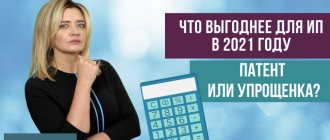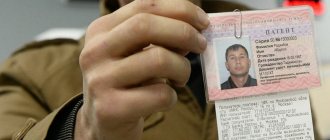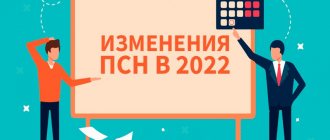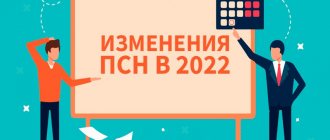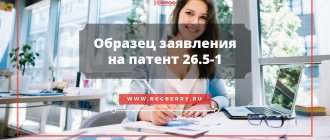Russian legislation provides for various tax regimes. Some of them can be used simultaneously, others cannot. Is it possible to combine a patent and the simplified tax system? Yes, the Tax Code does not prohibit this. The main thing is to do everything correctly, taking into account the limitations of both systems and the rules for their joint use. Let's figure out why this is needed and how it works in 2022 for individual entrepreneurs.
Free tax consultation
Combination principles
When combining the simplified tax system and patent regime in 2022, a number of rules apply to individual entrepreneurs. The main one is that all the activities of the entrepreneur are transferred to simplified language, while patents can be acquired only for those areas for which they are valid in a specific region.
You can combine the simplified tax system and a patent in different ways:
- Within one region, an entrepreneur using the simplified tax system can buy a patent for certain types of activities (or several). For example, a simplified individual entrepreneur opened a grooming salon for dogs and cats. After some time, he decided to additionally open a small pet supply store and acquired a patent for this activity.
- In different regions, an individual entrepreneur may use different systems within the same activity. Let's say an individual entrepreneur from Rostov-on-Don is engaged in cargo transportation. A patent for 2 vehicles in 2022 cost him 22,560 rubles. The entrepreneur decided to expand the territory of activity and open a point in Krasnodar (2 more cars). However, a patent under the same conditions in this region will cost him 114,000 rubles! The individual entrepreneur has no confidence that things will immediately go well. Therefore, he decided not to buy a patent in the Krasnodar region, but to apply the simplified tax system.
Classic question: can an entrepreneur combine a patent and simplified tax system for one type of activity? In different regions, yes, but in one - no. This means that it is impossible, for example, to open one store using the simplified tax system and another using a patent.
But despite the fact that combining the simplified tax system and a patent for one type of activity in one region is generally prohibited, there are exceptions. In particular, it is allowed to tax, according to different systems, the activity of renting out real estate objects owned by individual entrepreneurs. For example, if he has 5 properties in one region, he can purchase a patent for two of them (or any other number). Their addresses are indicated in the patent. On income from leasing those objects that are not indicated in it, the individual entrepreneur will pay tax according to a simplified system.
In addition, a similar rule applies to the simultaneous sale of labeled goods (shoes, medicines, furs) and any others. The fact is that the sale of these goods on PSN is prohibited. However, an entrepreneur can sell shoes using the simplified tax system, and buy a patent to sell other goods, for example, items of clothing, accessories, bags. In this case, it is permissible to combine the simplified taxation system and the PSN for the same type of activity within the region and even within the same store.
Patent tax system
The patent tax system is a special regime for individual entrepreneurs, which appeared in 2013. The tax is calculated on potential income and there is no obligation to file declarations. Individual entrepreneurs on PSN keep a book of income accounting, according to which the tax authority determines whether the revenue limit is exceeded.
To use the system, entrepreneurs buy a patent - a permit to conduct activities. The cost depends on the number of employees, physical facilities, retail space and region.
A patent is issued for a period of 1 to 12 months. You can issue a permit for any number of days from 1 month within a calendar year. Therefore, PSN is often chosen for seasonal business to reduce costs.
To calculate the cost of a patent for your planned activity, use the online service of the Federal Tax Service.
Calculation of the tax amount on PSN
The potential income on which the tax amount depends is determined by regional authorities. Let's calculate the cost using a specific example.
Chelyabinsk entrepreneur Dmitry Nikolaevich Cherednichenko provides passenger taxi services without employees. For comparison with the simplified tax system, he decided to apply for a patent for 38 days.
Potential income from the selected activity for one car is 240,000 rubles. Let's calculate the value for 38 days: 240,000 ÷ 365 × 38 = 24,986.30 rubles.
The tax rate on PSN is 6%. The individual entrepreneur will pay for the selected period: 24,986.30 × 6% = 1,499.8 rubles.
Who can work on the patent tax system
The patent tax system is designed for small businesses, so there are a number of restrictions on application.
Firstly, regional authorities determine the list of permitted activities (clause 2). On PSN it is allowed to provide hairdressing and cosmetic services, repair furniture, residential and non-residential buildings. Please check with your local tax office for availability of your planned destination.
Secondly, there are restrictions on physical indicators:
- retail area - up to 150 square meters;
- vehicles for transporting passengers and cargo - up to 20 units;
- Wholesale trade is prohibited;
- and others listed in the sixth paragraph.
Thirdly, the average number of employees should not exceed 15 people (clause 5), and income for a calendar year from patent activities should not exceed 60 million rubles (clause 6).
How can you obtain a patent?
Individual entrepreneurs switch to a patent when registering an individual entrepreneur or when changing the tax regime.
1. Registration of individual entrepreneurs. An application for the use of PSN is submitted with documents for obtaining the status of an individual entrepreneur. This can be done in person or through a representative at the Federal Tax Service, by post with an inventory or electronically. In the latter case, you will need an electronic digital signature.
2. Regime change. If the business is already operating under a different taxation system, an application is submitted to the Federal Tax Service 10 days before the start of the activity.
It is important to take into account the planned direction and the possibility of combining a “patent” with another regime. If it is planned to open a new activity, a patent application is submitted at any day. The current “patent” direction is allowed to be transferred from the beginning of next year.
Application of the patent tax system may be refused due to:
- a ban by regional authorities on the use of PSN for selected activities;
- incorrect expiration date;
- loss of the right to use the “patent”;
- failure to pay the full cost of the previous permit;
- errors in the application.
The tax office reviews applications from individual entrepreneurs within 5 working days.
Disadvantages of PSN
1. Limitations. Users of the patent tax system cannot engage in any activity, and regional authorities regularly review the permitted list. There is no guarantee that the direction chosen this year will remain on the list of available options next year.
2. Duplication. When expanding - opening a new direction or providing the same services in another region - you need to buy a new patent. This increases the tax burden and reduces profits.
3. Fixed tax. The budget payment is calculated based on potential income. If actual revenue is less, the entrepreneur will incur additional expenses.
4. Payment terms. If an individual entrepreneur purchases a permit for a period of six months or more, one third of the cost must be paid within 90 days. This time may not be enough to promote the business, which creates additional difficulties.
Restrictions
Each of these preferential regimes has its own restrictions. Accordingly, in order to combine them, it is necessary to fit into these frameworks.
For individual entrepreneurs using the simplified tax system, the main restrictions are as follows:
- income since the beginning of the year does not exceed 200 million rubles, taking into account the deflator coefficient;
- the maximum number of employees on average per year is 130 people;
- the residual value of fixed assets that are used in “simplified” activities is 150 million rubles.
On PSN the limits are much more modest:
- income – no more than 60 million rubles;
- workers engaged in activities under a patent - no more than 15 people.
Moreover, for the possibility of purchasing a patent, the entrepreneur’s income from activities in both modes is taken into account. Let's explain with an example.
IP Ivanov is engaged in wholesale trade on the simplified tax system. In 2022, he opened retail stores on the patent. By the middle of the year, the business brought him the following income:
- wholesale – 40 million rubles;
- retail – 15 million rubles.
Total 55 million rubles. Everything is heading towards the fact that at the end of the next quarter, the total income of individual entrepreneurs for both types of activities will cross the bar of 60 million rubles. This means that it will lose the right to apply the patent system for retail trade from the beginning of the year. By the way, in this case, the entrepreneur could save money if he purchased a patent not for the whole year at once, but for six months/quarter.
What are the benefits of combining simplified taxation system and PSN
The effect of the combined use of the two systems should be assessed individually in each case. However, most often the combination of simplified taxation system and PSN is justified. The cost of a patent is usually less than the amount of tax under the simplified tax system for the same type of activity. That is, the use of two systems is relevant if the activity for which it is planned to buy a patent provides significant income.
But it should be taken into account that now the regions independently set the indicator on the basis of which the cost of the patent is calculated. This is the maximum income that an individual entrepreneur can theoretically receive from this activity. Previously, its maximum value was established in the Tax Code of the Russian Federation, but now this restriction has been removed. And there are already known cases when regional authorities set such a high income limit that the tax under the PSN became prohibitively large (as in the example above with the Krasnodar Territory). Accordingly, combining the simplified tax system and a patent has become less profitable.
So, before combining systems, you need to calculate the cost of the required patent in your region. This can be done in a special calculator.
Another benefit from the combination can be obtained in the future. For example, if you plan to develop additional areas of business, because not everything falls under the PSN. However, if the individual entrepreneur at one time took care of the transition to a simplified regime, then the new activity, if there is no patent for it, will be taxed according to the rules of the simplified tax system. Otherwise, at least until the end of the year, the main regime will have to be applied to the newly opened direction.
And finally, when combined, the problem of exceeding patent limits is easier to solve. For example, if an individual entrepreneur’s income from the beginning of the year exceeds the level of 60 million rubles, then he will lose the right to PSN. When combining regimes, in this case you will have to pay tax on the simplified tax system. If the entrepreneur does not take care of this, he will end up in the general (basic) tax regime, where taxes are higher.
What are the difficulties of combining
The disadvantages of combining are that it is necessary to separately take into account income, expenses, and employees. That is, the entrepreneur will have to keep two accounting books. In addition, once a year it is necessary to submit a declaration under the simplified tax system, even if no activity was carried out within the framework of this system (the report in this case will be zero).
However, all this is not particularly difficult. Difficulties arise in the question of how to keep records. We'll talk about this later.
Employee records
The combination of the simplified tax system and a patent in 2022 assumes separate accounting of personnel hired under employment contracts. Persons on GPC, including the self-employed, are not taken into account. At the same time, the number in different modes does not add up.
In other words, an individual entrepreneur on a patent and the simplified tax system can simultaneously have a total of no more than 145 people: 130 on the simplified tax system and 15 on the PSN. But there is a nuance here: this is true provided that employees are engaged exclusively in activities according to one mode. However, this rarely happens. As a rule, some of the personnel can be classified as both the PSN and the simplified tax system.
Let's return to our example about IP Ivanov. In the wholesale trade area, he employs 30 people in the office and warehouse - they are taken into account within the simplified framework. Another 10 people work in retail stores - they belong to PSN. In addition, there is an accountant and a driver, whose work cannot be classified strictly as wholesale or retail.
Where to include such employees? Obviously in both categories. That is, it turns out that IP Ivanov has 32 people taken into account within the framework of the simplified tax system, and 12 - within the framework of the PSN. Although he has a total of 42 employees.
Income accounting
Income from PSN is taken into account to track limits, and in a simplified version, also to calculate the tax base. The approach is simple: income within each tax regime is recorded in its own Account Book.
Some difficulties may arise with the identification of income that comes from one cash register, used both on the simplified tax system and on the PSN. Mentioned above was the possibility of selling shoes using the simplified tax system, and other goods using a patent. So, this is exactly the case if one cash register is used.
Cost accounting
If the simplified tax system is used with the object “Income minus expenses,” then costs must also be taken into account. The principle is the same as when accounting for income, that is, summing up costs within the regime. But many of them cannot be attributed to one or another system in its pure form (the same as with employees). They are taken into account in proportion to the share of income from activities in the total income of the business.
Let's return to IP Ivanov. His income under the simplified tax system is 40 million rubles, and under the PSN – 15 million rubles. Expenses are distributed as follows: for a simplified system - 25 million, for a patent - 10 million, total expenses - 1 million rubles. Let's distribute the amount of total expenses between modes:
- IP income: 40 million + 15 million = 55 million rubles;
- share of income from the simplified tax system: 40 million / 55 million *100% = 72.7%;
- the amount of total expenses attributable to the simplified tax system: 1 million * 72.7% = 727 thousand rubles;
- the amount of total expenses attributable to the PSN: 1 million – 727 thousand = 273 thousand rubles;
- total expenses for the simplified tax system - 40,727,000 rubles, for the special tax system - 15,273,000 rubles.
On the simplified tax system Income, costs are not taken into account, but the amount of insurance premiums paid can be deducted from the tax.
In 2022, individual entrepreneurs on PSN will also be able to take into account contributions - they can be used to reduce the cost of the patent. Insurance payments should be taken into account separately - within the framework of the regime to which the employee is assigned. Contributions for the “general” staff, as well as for the entrepreneur himself, are distributed in proportion to the shares of income - exactly the same as shown above for expenses.
Simplified taxation system
The simplified taxation system is a special regime that replaces VAT and personal income tax. Individual entrepreneurs pay a single tax, the amount of which depends on the selected subtype of the simplified tax system:
- “Revenue” - 6% of all revenue;
- “Revenue minus expenses” - 15% of the difference between revenue and expenses.
Regional authorities are allowed to reduce rates: up to 1% for “Revenue” and up to 5% for “Revenue minus expenses”.
Not all costs can be used to reduce the tax base. The list of permitted expenses is established by law, and each payment must have documentary evidence. Otherwise, the Federal Tax Service will recalculate the tax and charge a penalty for late payment of the budget payment.
If an entrepreneur is engaged in banking services, organizes gambling, develops a pawnshop or produces excisable goods, it is prohibited to use the “simplified tax”.
If an individual entrepreneur began to carry out prohibited activities after switching to the simplified tax system, he will be forcibly transferred to OSNO from the quarter in which he violated the restriction.
As with PSN, there are restrictions on the number of employees and income:
- up to 100 people;
- up to 150 million rubles.
In 2022, a transition period was introduced for entrepreneurs who violated restrictions. Now they are not immediately transferred to OSNO and are given time to adapt. It is valid until:
- revenue is in the range from 150 to 200 million rubles;
- The number of employees ranges from 100 to 130 people.
During the transition period, tax rates increase to 8% on “Income” and to 20% on “Income minus expenses”.
To switch to the simplified system, a notification is submitted to the Federal Tax Service at the place of registration. It is best to submit the form with documents for registration as an individual entrepreneur or within a month after receiving the status. If you don’t meet the deadline, the individual entrepreneur is registered under OSNO, and you can switch to the special regime only from the beginning of next year.
